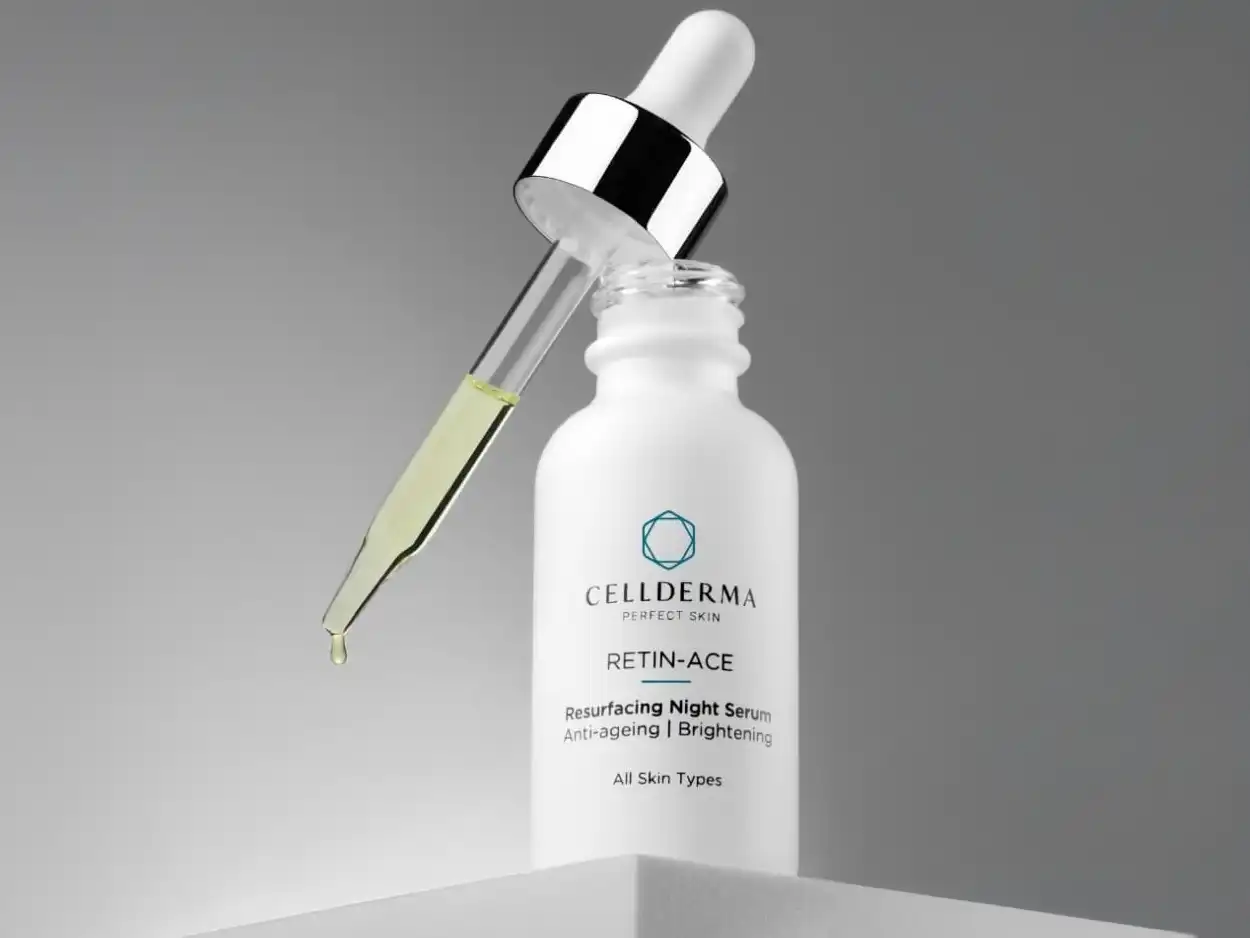Cellderma is quietly becoming a dermatologist’s favorite for science driven formulas that feel indulgent rather than clinical. While it may not yet be a household name its reputation among skincare insiders is steadily glowing.
The latest launch, Retin-Ace Resurfacing Night Serum, arrives with a cape already fluttering in the marketing wind. The name itself reads like a promise of superhero strength and according to Cellderma the serum packs a next-gen retinoid that is said to outperform standard retinol while sidestepping the usual redness, dryness and peeling. They also highlight a supporting cast of vitamins C and E for brightening and firming plus squalane for lightweight hydration.
I spent two solid weeks putting this nighttime treatment through its paces, observing how my combination skin reacted, how it layered with the rest of my routine and whether the results justify the price tag.
Disclaimer: this review is not paid or sponsored. All opinions are my own based on personal experience and individual results can differ.
What Is Retin-Ace Resurfacing Night Serum?
Retin-Ace Resurfacing Night Serum is an overnight treatment from Cellderma that pairs a high strength retinoid called hydroxypinacolone retinoate with antioxidant vitamins C and E. Overnight treatments are leave-on formulas designed to work while you sleep when skin is naturally in repair mode. They tend to contain active ingredients at concentrations that might feel too intense for daytime use and they are meant to be applied as the first step after cleansing, then left undisturbed until morning.
This particular serum promises many of the benefits usually linked to retinol such as boosting cell turnover, softening fine lines and improving uneven tone but it claims to do so with fewer of the side effects that beginners often experience. The inclusion of plant-based squalane and seed oils provides light hydration so the formula sits somewhere between a treatment and a moisturiser. It is classed as non-comedogenic which means it should not clog pores, making it suitable for most skin types including combination and oily.
The brand recommends starting with two nights a week and building up to nightly use if your skin stays comfortable. As with any retinoid routine daily sunscreen is essential because fresh skin cells at the surface are more vulnerable to sun damage.
Did It Work?
In the name of rigorous research I parked my usual glycolic sleep mask for a full three nights before starting Retin-Ace. Very scientific I know but I wanted a clean slate and figured 14 days was long enough to spot meaningful changes.
Night one and two followed the instructions to the letter: a pea-sized pump smoothed over clean skin then left to do its thing under a basic ceramide cream. The texture is silkier than the average retinoid serum so there was zero pilling with the moisturizer and no dryness by morning. What I did notice after the second application was a faint warm flush that faded in about fifteen minutes. No stinging no flakes so I upgraded to every other night for the rest of week one.
By day seven my forehead looked a touch clearer and makeup sat more evenly on the pores around my nose. Breakouts were business as usual meaning no new congestion but also no miraculous disappearance of the hormonal bump on my chin. Encouraged I went nightly for week two. Here the brightening claim started to show up: residual post-blemish marks lightened a shade or two and overall tone looked less sallow. Fine lines at the outer corners of my eyes appeared slightly softer though that could be the squalane’s cushioning effect rather than deeper structural change.
The one promise that fell short was the supposed irritation-free experience. While I escaped peeling I did wake up twice with a tight feeling along my cheeks that needed an emergency layer of rich cream. Nothing dramatic yet enough to remind me that high potency still asks for respect.
So did it work? Mostly yes. Skin looked smoother the texture impressed me and the subtle glow arrived faster than with classic retinol. Still the improvements plateaued after the second week and the occasional tightness makes me hesitate to retire my current routine. For that reason Retin-Ace earns a passing grade but will not claim permanent residency on my shelf.
Retin-Ace Resurfacing Night Serum’s Main Ingredients Explained
The headline act is Hydroxypinacolone Retinoate, often shortened to HPR, a next generation retinoid that binds directly to retinoid receptors without the two-step conversion classic retinol needs. In practice that means faster visible results at equivalent concentrations and a lower chance of the dramatic peeling that can scare newcomers. It is still vitamin A though, so anyone who is pregnant or trying to conceive should steer clear unless a medical professional gives explicit permission.
Backing up the retinoid are two fat-loving antioxidants. Tetrahexyldecyl Ascorbate is a stable oil soluble form of vitamin C that can penetrate the lipid layer more easily than ascorbic acid and helps fade post-blemish pigment while spurring collagen production. Tocopheryl Acetate, a storage form of vitamin E, partners with vitamin C to neutralise free radicals and adds a mild anti-inflammatory benefit that can take the edge off retinoid dryness.
The formula leans on lightweight emollients for its cushiony feel. Plant derived Squalane mimics the skin’s own sebum giving a soft finish without suffocating pores and it is classified as non-comedogenic. Dimethicone, a silicone often maligned, actually forms a breathable barrier that locks in moisture and rarely provokes breakouts. The one potential congestion trigger is Caprylic/Capric Triglyceride which has a moderate comedogenic rating for some users meaning it can clog pores if your skin is already prone to bumps. Carrot seed and rosehip oils sit in the same middle ground so highly acneic skin may want to patch test before going nightly; comedogenic simply means a substance has the potential to block pores and generate blackheads or pimples.
Delivery helpers deserve a nod. Dimethyl Isosorbide acts as a solvent that ferries the active retinoid deeper, while Bisabolol, extracted from chamomile, soothes any low grade inflammation that might sneak through.
The preservative system uses Phenoxyethanol with Ethylhexylglycerin, both broadly tolerated and fragrance free which lowers the risk of irritation for sensitive noses.
No animal derived raw materials appear on the INCI list so the serum reads as vegan and vegetarian friendly, though strict vegans may still want confirmation from the brand about manufacturing processes. The absence of added fragrance and the reliance on stable antioxidant esters are small but welcome bonuses in a retinoid serum at this price point.
What I Liked/Didn’t Like
Here is the quick takeaway after two weeks of nightly use.
What Works Well:
- Silky lotion-serum texture sinks in fast and layers effortlessly under any night cream
- Delivers a visible brightening boost within a week with no flaking and only minimal flush
- Fragrance free formula with squalane and dimethicone keeps combination skin comfortably hydrated without feeling greasy
- Airless pump gives a consistent pea sized dose which helps avoid overuse
What to Consider:
- Some users may still feel occasional tightness so a buffer moisturizer or slower ramp up is wise
- Results seemed to level off after the initial glow meaning long term payoff may require pairing with other actives
- Price sits at the higher end of mid market serums which could be hard to justify if you already tolerate classic retinol
My Final Thoughts
After a fortnight of nightly dates with Retin-Ace I can honestly say it is a solid performer rather than a life-changing love affair. It delivers a brisk glow, smoother makeup days and a polite softening of fine lines, yet it still managed to remind me of its potency on those mornings my cheeks felt papery. If you are a retinoid novice with combination or normal skin and you want faster results than classic retinol without peeling like a croissant, this serum is worth a look. If you are already on prescription strength or your wallet flinches at mid-premium pricing you may find the payoff too incremental.
I have tested more night treatments than I care to admit, so I feel I gave this one a fair shake. On my shelf it earns a respectable 7 / 10 and yes I would recommend it to a friend who is hunting for a step up from beginner retinol, provided they are willing to watch for the occasional dryness and pair it with a comforting cream.
Speaking of comfort, there are some excellent alternatives if Retin-Ace does not quite tick every box. Nocturnal Revive Cream by Deascal is my budget friendly all-rounder that covers hydration, gentle exfoliation and barrier support in one unfussy bottle. For those who prefer a classic retinol cream, Intelligent Retinol Smoothing Night Cream by Medik8 offers a similar brightening trajectory with an even creamier cushion. If soothing is your priority the Cica Sleeping Mask by LANEIGE cloaks skin in centella-rich calm and pairs beautifully with acids used earlier in the week. Texture obsessives might fall for the Watermelon Glow AHA Night Treatment by Glow Recipe which combines a mild acid swirl with pillow friendly hydration and a scent that makes you forget skincare is supposed to be serious.
Before you slather anything new please remember the unglamorous basics: patch test behind the ear or along the jaw for a few nights, increase frequency slowly and keep sunscreen in your morning ritual. Sorry to sound like an over-protective parent but irritated skin is no badge of honour. Finally, any glow you gain must be maintained so keep the bottle in rotation if you want the results to stick around.

